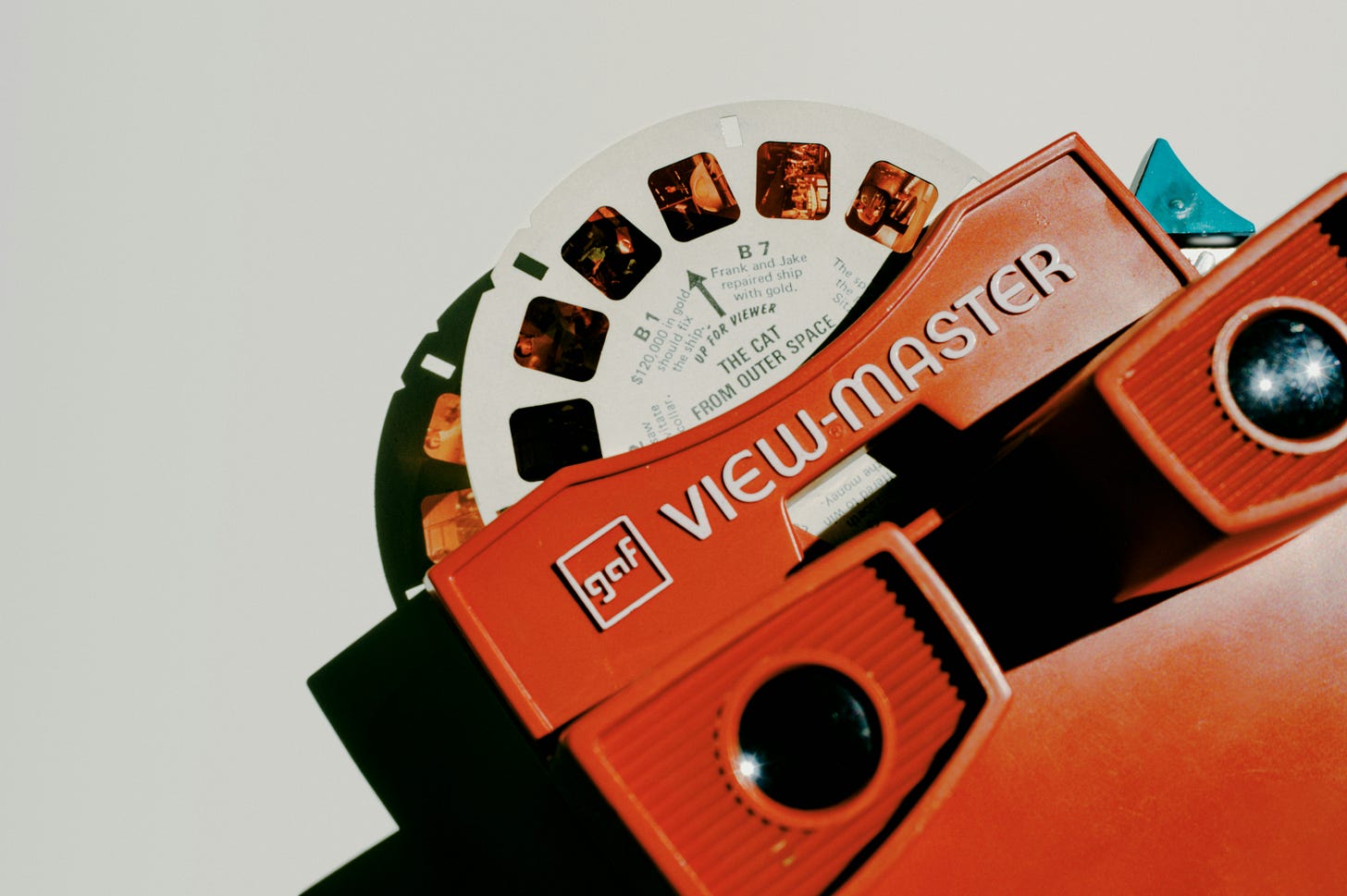A natural history of the View-Master toy
The history of the stereoscope shows how changing technology changes the way a culture experiences nature

When I was a kid, I had a View-Master. Plenty of kids get these toys from Santa Claus, complete with a set of themed images to view. I have fond memories of the View-Master: saying “Wow, this is cool!” and showing it to my sister and my friends. But eventually I lost interest. My parents presumably, wisely, somehow eventually got rid of it.
Which was why I was so surprised to learn that 130 years ago, this was the primary way that all people, children and adults alike, experienced Yellowstone National Park.
The View-Master, as you likely recall, made pictures appear to be three-dimensional. It came with reels that contained several paired images. Because the contraption—a special-format stereoscope—focused each eye on a slightly different image, your brain merged them in a way that took advantage of your binocular depth perception to give the illusion of three dimensions.
This illusion is great for kids. You could show them a bunch of picture-postcards, but this higher-tech device has an additional gee-whiz factor. As they explore their senses, this toy appears to extend their visual sense far beyond what’s natural. They may become fascinated by the brain science behind it, and/or by the images they see.
The View-Master debuted at the 1939 New York World's Fair. It was originally intended for adults. Indeed, during World War II the Army bought 100,000 viewers to train soldiers; later a doctor used the View-Master to teach human anatomy. But its debut reels featured pictures of Carlsbad Caverns and Grand Canyon National Parks.
That’s because the stereogram (the official name of those twinned images) had long been a preferred way to view scenes of nature and national parks. Special cameras produced the stereograms, and famed frontier photographer William Henry Jackson brought one of those cameras on his 1871 expedition to Yellowstone.
People viewed these images with stereoscopes, which were basically primitive View-Masters, slightly more complicated and fragile, but very much intended for popular audiences’ home use. It was a leisure activity, a party theme: you’d buy a boxed set of stereographs of some exotic place, and invite the neighbors over to enjoy them.
“Is it not like magic, the way everything stands out in space?” reads the text of a popular 1909 book on Yellowstone stereographs. The book argued that the effect gave “your experience the same reality as that of bodily travel.” In an era when travel was more difficult—and taking pictures required lots of expensive, unwieldy equipment—the stereoscope was the way most Americans experienced their nation’s natural wonders.

Eventually, technology marched on. Printing improved, and you could see nature on postcards or in color magazines. Movies showed nature in motion. Do-it-yourself cameras, such as Kodak’s Brownie, introduced in 1900, meant that rather than buying someone else’s natural views, you could gain the intimacy of creating your own. More recently, of course, cameras have migrated to our phones, and the act of viewing pictures now most often occurs on social media.
Meanwhile, by making an indestructible plastic viewer, the inventors of the View-Master were able to repurpose a quaint, antiquated technology as a children’s activity. For this they deserve much credit. Not only did they bring joy to young lives, and make money doing so, but they also gave our culture a reference point for the stereogram. Without the View-Master, it’d be really hard to explain why so many hundreds of thousands of historic images of nature are twinned.
And that’s important, because when people view nature, their experience is often mediated by culture. The ability to view nature “in 3-D” via late-1800s stereoscopes coincided with the rise of the nature preservation movement. The method of viewing those stereograms—socially, at a party with friends—helped people experience nature differently than they would have by reading about the solo sojourns of writers like Henry David Thoreau.
Furthermore, because you could linger over each stereogram, photographers were incentivized to make them complicated, with lots of details that might provide entertaining 3-D effects. By contrast, today, when you experience a nature photograph as part of an endless scroll, the reigning aesthetic is simple and clean.
Does that mean nature today is simpler and cleaner? No: we just experience it that way. Is nature less of a place for solo spiritual contemplation than it was for Thoreau? No: different technologies just create different experiences—even experiences of nature. Is nature today more for kids than adults? No: the inventors of the View-Master just happened to make it easier for them to consume.
Discussion:
I wrote about the history of stereoscopes and Yellowstone for Big Sky Journal in 2021.
For histories of the View-Master, see Kovel’s Antique Trader and the National Museum of Play.
In the comments, I’d be especially interested in ways that technology has mediated your own experiences of nature.




As technology continues to advance, what role does AI and CGI play in our experience of “wilderness”? We can visit Arrakis or Pandora or a world completely of the imagination where purple anteater/dolphin crosses swim through the sky almost as easily as the people of the late 1800 could visit Yellowstone on a stethoscope.
What a great flashback. We had one and it was always exciting to get a new disk to insert into the viewer. Thanks for the history.